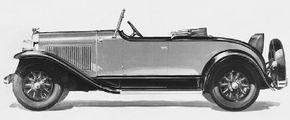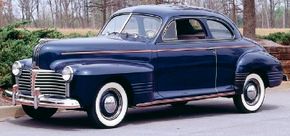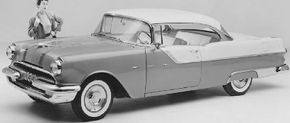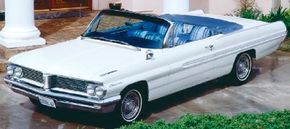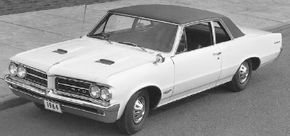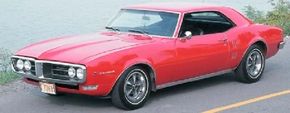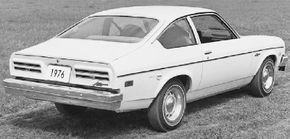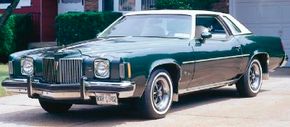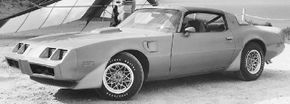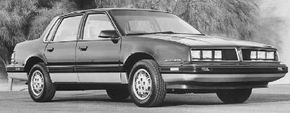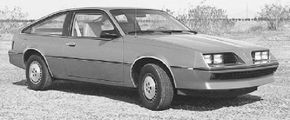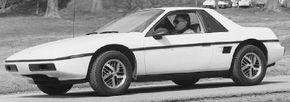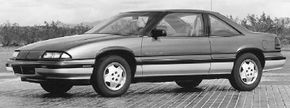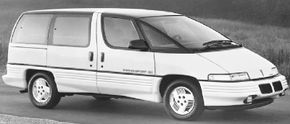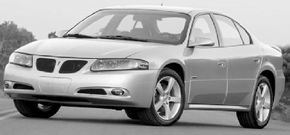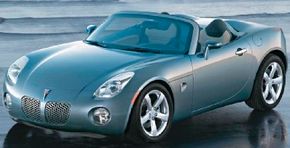Pontiac's personal-luxury coupe, the Grand Prix, had become almost invisible since its '78 downsizing, limping along after 1981 with somewhat smoother but still uninspired styling that strained at marrying "aero modern" with "middle-class traditional."
Engines were equally uninspired, mostly Buick V-6s and Chevy small-block V-8s, all economy-tuned. The trouble-prone Olds 350 diesel V-8 offered from 1981 to '84 only underlined the old-fogey aura of a car that was less important on the street than on NASCAR circuits (thanks to Richard Petty, and others).
But the GP's role as stock-car standard-bearer did lead to an interesting limited edition reviving the 2+2 handle. Introduced at mid-1986, this wore a wind-cheating body-color front instead of the usual stand-up brightwork, plus a huge "glassback" deck designed for smoother airflow to a bespoilered tail. GM Design concocted this configuration to counter Ford's more slippery new Thunderbirds in long-distance races.
But the GP's role as stock-car standard-bearer did lead to an interesting limited edition reviving the 2+2 handle. Introduced at mid-1986, this wore a wind-cheating body-color front instead of the usual stand-up brightwork, plus a huge "glassback" deck designed for smoother airflow to a bespoilered tail. GM Design concocted this configuration to counter Ford's more slippery new Thunderbirds in long-distance races.
As ever, NASCAR approval depended on building a set number of street models, hence this Pontiac and Chevy's similar Monte Carlo SS Aerocoupe.
Showroom 2+2s carried a four-barrel, 165-bhp Chevy 305 V-8--fair enough, considering all period GM competitors in NASCAR ran Chevy-based engines. If any Grand Prix built between 1978 and '87 will interest collectors, this is the one, though it's generated scant interest so far.
Showroom 2+2s carried a four-barrel, 165-bhp Chevy 305 V-8--fair enough, considering all period GM competitors in NASCAR ran Chevy-based engines. If any Grand Prix built between 1978 and '87 will interest collectors, this is the one, though it's generated scant interest so far.
The all-new '88 was a very different Grand Prix. Though it premiered with the same W-body/GM10 coupe platform as the latest Olds Cutlass Supreme and Buick Regal, its looks were pure Pontiac: sleek, purposeful, and obviously more "aero" than its blocky predecessor. It was more sophisticated, too, with standard all-disc brakes and four-wheel independent suspension.
Though 7.8 inches shorter overall than the '87, the '88 rode a wheelbase only 0.5-inch shorter. This, plus a transverse drivetrain (nearly universal with front drive), made for a much-roomier interior than before.
For the base and midrange LE models, that drivetrain involved a 130-bhp 173-cid Chevy V-6 with port fuel injection driving a four-speed automatic transaxle; a five-speed manual designed by Getrag of Germany was optional.
The five-speed was standard on the sporty SE, which came with a beefed-up suspension and more comprehensive instruments set in a very busy dash. Automatic GPs were upgraded to a stroked 3.1-liter (191-cid) V-6 during 1989, but the big thrill was a McLaren Turbo model powered by a blown 3.1 producing 200 bhp.
The "McTurbo" was another limited edition, developed with ASC/McLaren and planned for only 2000 copies.
Finished in monochrome red or black with gold-color accents, it rolled on sizable 16-inch lacy-spoke wheels fitted with Z-rated high-performance tires (safe at over 149 mph). Wheel openings were suitably flared for clearance via specific lower-body panels with wind-cheating "spats" at each wheel, plus a grooved rub strip carried into the bumpers at each end.
Like Ford with its '83 Thunderbird, Pontiac had come up with a car to revitalize a tired name. The McLaren was arguably the best GP yet for all-around performance.
Workaday Grand Prixs made a good sales start with model-year '88 volume of about 86,000. The '89s fared even better at just under 137,000, with optional antilock brakes a new inducement to buy. The 1990 total was a bit lower at 128,000 -- disturbing, as that included two new sedans, an LE and a reincarnated STE. Each was shapely, but the STE was both sporty and lush.
Among its no-cost features were antilock brakes, handling suspension, upgraded rolling stock, analog gauges (replacing contrived digigraphic), buckets-and-console interior, and an available 205-bhp 3.1 turbo V-6 (offered on a Turbo coupe as well). Bodyside cladding cluttered appearance, a bank of running lights between the headlamps looked me-too next to the Mercury Sable (which had this first), and the standard powertrain teamed the unexciting 140-bhp 3.1 V-6 with mandatory four-speed automatic.
Still, it was heartening to see the STE continue, and the LE was a fitting replacement for the 6000 as Pontiac's mainstream family four-door.
Pontiac's personal-luxury coupe, the Grand Prix, had become almost invisible since its '78 downsizing, limping along after 1981 with somewhat smoother but still uninspired styling that strained at marrying "aero modern" with "middle-class traditional."
Engines were equally uninspired, mostly Buick V-6s and Chevy small-block V-8s, all economy-tuned. The trouble-prone Olds 350 diesel V-8 offered from 1981 to '84 only underlined the old-fogey aura of a car that was less important on the street than on NASCAR circuits (thanks to Richard Petty, and others).
But the GP's role as stock-car standard-bearer did lead to an interesting limited edition reviving the 2+2 handle. Introduced at mid-1986, this wore a wind-cheating body-color front instead of the usual stand-up brightwork, plus a huge "glassback" deck designed for smoother airflow to a bespoilered tail. GM Design concocted this configuration to counter Ford's more slippery new Thunderbirds in long-distance races.
But the GP's role as stock-car standard-bearer did lead to an interesting limited edition reviving the 2+2 handle. Introduced at mid-1986, this wore a wind-cheating body-color front instead of the usual stand-up brightwork, plus a huge "glassback" deck designed for smoother airflow to a bespoilered tail. GM Design concocted this configuration to counter Ford's more slippery new Thunderbirds in long-distance races.
As ever, NASCAR approval depended on building a set number of street models, hence this Pontiac and Chevy's similar Monte Carlo SS Aerocoupe. Showroom 2+2s carried a four-barrel, 165-bhp Chevy 305 V-8--fair enough, considering all period GM competitors in NASCAR ran Chevy-based engines. If any Grand Prix built between 1978 and '87 will interest collectors, this is the one, though it's generated scant interest so far.
As ever, NASCAR approval depended on building a set number of street models, hence this Pontiac and Chevy's similar Monte Carlo SS Aerocoupe. Showroom 2+2s carried a four-barrel, 165-bhp Chevy 305 V-8--fair enough, considering all period GM competitors in NASCAR ran Chevy-based engines. If any Grand Prix built between 1978 and '87 will interest collectors, this is the one, though it's generated scant interest so far.
The all-new '88 was a very different Grand Prix. Though it premiered with the same W-body/GM10 coupe platform as the latest Olds Cutlass Supreme and Buick Regal, its looks were pure Pontiac: sleek, purposeful, and obviously more "aero" than its blocky predecessor. It was more sophisticated, too, with standard all-disc brakes and four-wheel independent suspension.
Though 7.8 inches shorter overall than the '87, the '88 rode a wheelbase only 0.5-inch shorter. This, plus a transverse drivetrain (nearly universal with front drive), made for a much-roomier interior than before.
For the base and midrange LE models, that drivetrain involved a 130-bhp 173-cid Chevy V-6 with port fuel injection driving a four-speed automatic transaxle; a five-speed manual designed by Getrag of Germany was optional.
The five-speed was standard on the sporty SE, which came with a beefed-up suspension and more comprehensive instruments set in a very busy dash. Automatic GPs were upgraded to a stroked 3.1-liter (191-cid) V-6 during 1989, but the big thrill was a McLaren Turbo model powered by a blown 3.1 producing 200 bhp.
The "McTurbo" was another limited edition, developed with ASC/McLaren and planned for only 2000 copies. Finished in monochrome red or black with gold-color accents, it rolled on sizable 16-inch lacy-spoke wheels fitted with Z-rated high-performance tires (safe at over 149 mph). Wheel openings were suitably flared for clearance via specific lower-body panels with wind-cheating "spats" at each wheel, plus a grooved rub strip carried into the bumpers at each end.
Like Ford with its '83 Thunderbird, Pontiac had come up with a car to revitalize a tired name. The McLaren was arguably the best GP yet for all-around performance.
Workaday Grand Prixs made a good sales start with model-year '88 volume of about 86,000. The '89s fared even better at just under 137,000, with optional antilock brakes a new inducement to buy. The 1990 total was a bit lower at 128,000 -- disturbing, as that included two new sedans, an LE and a reincarnated STE. Each was shapely, but the STE was both sporty and lush.
Among its no-cost features were antilock brakes, handling suspension, upgraded rolling stock, analog gauges (replacing contrived digigraphic), buckets-and-console interior, and an available 205-bhp 3.1 turbo V-6 (offered on a Turbo coupe as well).
Bodyside cladding cluttered appearance, a bank of running lights between the headlamps looked me-too next to the Mercury Sable (which had this first), and the standard powertrain teamed the unexciting 140-bhp 3.1 V-6 with mandatory four-speed automatic.
Still, it was heartening to see the STE continue, and the LE was a fitting replacement for the 6000 as Pontiac's mainstream family four-door.
For more on the amazing Pontiac, old and new, see:
For more on the amazing Pontiac, old and new, see:
- Pontiac New Car Reviews and Prices
- Pontiac Used Car Reviews and Prices
